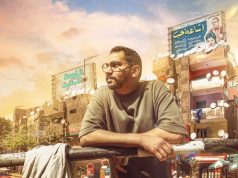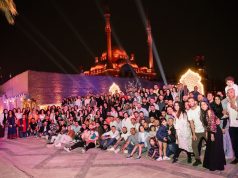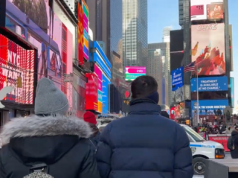Every bit as charismatic and captivating as his widely appreciated works of art, Egyptian-born, Barcelona-based artist Hossam Dirar exudes an energy and intensity that keeps you riveted. Expressive in recounting his artistic journey, Dirar quickly held the Cairo West Magazine team in his thrall when we recently met up.
CWM: Hossam, how old were you when your artistic talent surfaced?
HD: I don’t remember exactly, but from a very early age the walls of my grandparents’ house were full of my drawings. My grandfather had to repaint everything every couple of years. Anything I could draw on, my schoolbooks, papers, all met the same fate. My friends learned quickly and refused to lend me their books.
By the age of ten I was actually more interested in music, so I started playing guitar. It was another way of discovering and expressing variations of tone in an artistic way.
What formal art studies have you undertaken?
I attended the Faculty of Applied Arts of Helwan University, studying art, design and graphics. My interest then lay in the newly developing trends in TV advertising and graphic design. It hadn’t crossed my mind that I could make it as an artist; I just wanted to be a good designer.
Over the years I have gone on to study under several important artists, and now I have embarked on my Master’s in Fine Art in Barcelona. Along the way, I earned two diplomas from the Salzburg Academy of Art, one for Abstract Painting and one for Short Experimental Filmmaking. I am currently exploring the world of natural sounds as a conceptual art form, and making a film using the iconic Al Hambra Palace in Andalucía as my ‘studio’. I have never cried in my life the way I cried when I first experienced the beauty and history of Al Hambra. I have obtained a special license that permits me to be alone while creating my new work there.
My study of art came not only though formal learning. It has been an absorption process. From 2008 through 2011 I travelled extensively and devoured both great and small galleries around Europe. It triggered something inside me, so I immersed myself in what I saw and found inspiration, as well as a deeper understanding through studying the work of great painters.
Your style seems to be continuously evolving, how would you describe the process?
From the years 2000 through 2006 I was committed to commercial design and was purely a designer. The transition to painting came without any conscious decision. I worked gradually on visualizing my ideas and finding ways to apply them. My travels in Europe were part of this evolutionary journey. With the impact of the events in Egypt of 2011, I took the decision to make major changes in my life. I closed my successful advertising agency and stopped doing any commercial work.
I dedicated my time at home to reading about art, and nourishing the seeds of a concept for my first pieces. During the revolution of 2011, I had taken a lot of photos. I created three collages with these and when I stumbled by chance across Safarkhan Gallery, I showed them my work. They liked what they saw, so I proceeded to create a total of 12 collages. That became my first exhibition and it boosted my confidence in becoming an artist.
My time in Europe led me to take a more experimental approach than is normally found in Egypt. I developed my own techniques using oil paints. I played with brushes, canvas and other materials until I reached my ‘style’. Nature resonates strongly with me; I love painting outdoors, in parks and open spaces.
What was the inspiration behind your ‘Women’ series of portraits?
This came from a very personal level. Raised in Egypt in a conservative society, I had little interaction with women in my early years and until the age of around 30 I was actually quite shy. It wasn’t until I travelled and entered a more liberal milieu in Europe that I developed closer relationships and had the chance to understand and observe my female friends more intimately. These paintings are my perception of the essence of each woman’s unique persona, spirit, and beauty.
How did your work become so well known internationally?
It came about through Saatchi online gallery (see Address Book at end of issue for details). I submitted some pieces, and they became the first gallery to show my ‘Women’ collection. They liked my work and I was selected as one of their best young artists. That acted as a springboard and I started to receive a lot of interest from Europe and the Middle East. It really opened a lot of doors for me.
Where are your paintings now?
Many are in private collections, one is in the Copelouzos family owned museum/gallery in Greece, and one is in the Egyptian Embassy in Vienna. There is a special piece, an abstract painting that is very personal and close to my heart that has never been, and may never be, exhibited. Possibly only in a museum. I created it in one night, using a lot of materials. It was a watershed moment; I felt I had actually gained the status of ‘artist’.
What role do you see art playing in our lives?
For me, art does two things. It is a way of seeing things from a different perspective, and it’s where you can share your vision and interpretation. It can guide people to see things differently; it opens up their perception of life. They can become aware of the diversity of life and grow beyond their closed ideas. In societies like the Middle East, you need art more than water or food. For most problems the Middle East is suffering from now, the solution is art.
Where did you hold you most recent exhibition?
It was in Los Angeles. They approached me about being part of a six-artist group exhibition. It was a new market for me, and I must admit it shattered my misconceptions. I had considered it to be a very commercial market where people did not really understand art. This was not the case. It was such a positive experience; I have planned a solo exhibition for next year.
And your next exhibition?
Here in Cairo in November at Art Talks Gallery. I am excited, as it will focus on a new direction in my work. I have evolved into a more abstract style, something that has been brewing since 2014 and 2015. It has been a while in the works.
Quickfire Round
Last book read?
The Meccan Revelations Volume 1 by Ibn Arabi
Habit that annoys you in other people?
Closed-mindedness.
Habit you would like to correct in yourself?
I want to start to get up early … to have more time with friends.
Best holiday ever?
When I visited Spain for the first time.
Favorite natural aroma?
Everything natural is a favorite for me.
Early bird or late riser?
I am a late riser, but I hope I can change that these days … I miss being an early bird.
Coffee or tea?
Coffee, coffee, coffee – without sugar, without milk.
Favorite period in history?
The time of Andalucía.
Dream guest list for a cozy lunch party?
I do not care much about particular guests; I am more interested in a positive energy flow with new faces and old friends.







